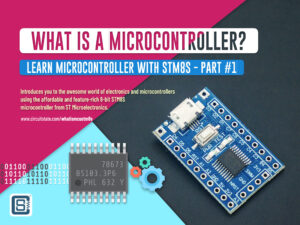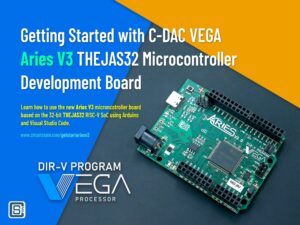Conexio Stratus – nRF9160 Based Open Source Cellular-IoT Platform with Energy Harvesting Feature
Those who have read our post about Nordic Semi’s nRF9160 LTE-M/NB-IoT System-in-Package would be familiar with its features that make it a great choice for Cellular-IoT applications. If you were looking for a fully integrated and small development board for it, now may be the time. Because Conexio Technologies Inc. is about to launch their new nRF9160 based development board called Stratus, via Crowd Supply. There are already a dozen of boards based on nRF9160, but the Stratus stands out by integrating a unique solar energy harvesting feature so that your application can be fully self-reliant on power once deployed. Energy from connected solar cells can be used to charge a battery and power the system without any interruptions. Conexio Stratus also comes bundled with a 500MB data package that you can use in 100+ countries. There is a mikro BUS compatible shield available for expansions. Zephyr RTOS is the go-to software platform for Stratus, for which Conexio has developed a VS Code extension to accelerate development. The Stratus project is completely open source, and if you want to get your hands on one, subscribe to the Crowd Supply campaign page to get notified when it is launched.
Features and Specifications of Stratus
- MCU
- Nordic nRF9160 SiP Microcontroller with single core ARM Cortex M33
- 64 MHz clock
- 1 MB Flash
- 256 kB RAM
- ARM® TrustZone®
- ARM® Cryptocell 310
- Up to 4x SPI, I2C, and UART with Easy DMA
- I2S w/ EasyDMA
- 4x PWM with EasyDMA
- 12bit SADC with EasyDMA
- 2x RTC
- PPI (Programmable peripheral interconnect) interface
- Modem
- Transceiver and baseband
- 700-2200 MHz LTE band support
- 3GPP LTE release 13 Category M1 and NB1 compliant
- 3GPP release 14 NB2 compliant
- GPS receiver (GPS L1 C/A supported) – Active antenna only.
- RF Transceiver for global coverage supporting bands:
- Cat-M1: B1, B2, B3, B4, B5, B8, B12, B13, B14, B17, B18, B19, B20, B25, B26, B28, B66
- Cat-NB1/NB2: B1, B2, B3, B4, B5, B8, B12, B13, B17, B18, B20, B25, B26, B28, B66
- Supports 4FF Nano SIM
- Pre-programmed MCUBoot bootloader
- Micro USB
- For USB-to-Serial, DFU, and application firmware programming and debugging plus LiPo battery charging
- Energy harvester IC
- AEM10941 solar energy harvester from E-peas Semiconductors
- Vin: 50 mV to 5 V
- Cold start: 3 μW @ 380 mV
- Power input: 3 μW to 550 mW
- Maximum power point tracking (MPPT)
- Supports battery types Li-ion and NiMH
- Max solar panels: up to 7 solar cells simultaneously
- Board power supply
- 3.3 V Buck/Boost up to 0.9 A of current draw
- Operating range 2.8 to 5.5 V
- External LiPo battery connection (2 Pin JST type)
- Charge rate set to 300 mA with yellow LED indication
- Maximum output current: 800 mA
- Current consumption in low-power-mode: < 5 uA
- Debugger & Programmer
- Supports J-Link and CMSIS-DAP based programmers
- 10-pin 0.05″ (1.27 mm) pin connector
- User I/O
- 32 Standard GPIOs (0.1″ pitch)
- 26 user-programmable GPIOs
- 2 x push buttons (1 Reset, 1 General Purpose connected to P0.12)
- 1 x user-programmable Green LED connected to D7 (P0.03)
- Antenna connections
- 1 x U.FL for LTE-M/NB-IoT with matching network
- 1 x U.FL for active GPS antenna
- Onboard sensors
- Latest SHT4x temperature and humidity sensor from Sensirion
- ST Microelectronics LIS2DH MEMS digital output motion sensor: ultra-low-power high-performance 3-axis Femto accelerometer
- Power switch
- SPDT slide switch for turning ON/OFF the power to the Stratus board
- Physical
- 50.8 mm x 22.86 mm (2.0″ x 0.9″)
- Weight: ~5 grams.
The nRF9160 is rich in features and connectivity options. The System-in-Package (SiP) has a small physical profile and supports both LTE-M (Long Term Evolution for Machines) and NB-IoT (Narrowband IoT) through a large set of radio bands to provide global network coverage. This makes it a good choice for applications that will be deployed globally. nRF9160 also crams a GPS inside. Both LTE-M and NB-IoT are designed for low-power and low-throughput communications necessitated by portable and battery powered Internet-of-Things (IoT) devices. IoT devices with Wi-Fi and Bluetooth require an access point or an internet gateway situated nearby. This limits their applications in terms of mobility. But Cellular-IoT devices are designed to be deployed on a larger geographical area where there might not be any other connectivity options. This gives them greater advantages over assisted IoT devices in terms of mobility and the easiness for deployment and maintenance. For example, think of sensors deployed in remote locations where accessibility is limited. Installing wireless access points in such places can be difficult, expensive and requires strict maintenance.
Stratus has everything needed for a portable Cellular-IoT device. The AEM10941 solar energy harvester IC from e-peas Semiconductors can extract power from connected solar cells and charge and monitor both Li-Ion or NiMH battery types. A two pin connector is present on the board for connecting the battery. The 3.3V supply for the nRF9160 comes from TI’s TPS63031 high-efficiency single inductor buck-boost converter with a wide range of input voltage of 1.8V to 5.5V. The bottom side of Stratus has a slot for nano SIM. One of the two push-buttons is for reset and the other is general purpose and user definable.
One thing we should be wary of when deploying Cellular-IoT devices in remote places is the environmental changes that could disturb the device’s performance. Stratus can be fully enclosed inside a weather-sealed enclosure, because it has two U.FL connectors for both cellular network and the GPS. That means, the antennas can be placed on the outside of enclosure while the main system remains sealed from the outside environment. In case the environmental sealing is compromised, Stratus can sense it using the Sensirion SHT40 present on the PCB. It is a fully calibrated humidity and temperature sensor that can even work in condensing environments. Physical tampering or accidents can be detected with the on-board LIS2DH 3-axis accelerometer from ST Microelectronics.
The SPDT slide switch present makes it easy to control the power to the system, instead of unplugging the battery or USB every time. A standard 10-pin header is available for programming and debugging through J-Link and CMSIS-DAP based programmers. USB serial connectivity is available through a Micro-USB port, and that is the only short coming we could find on Stratus. We hope Conexio upgrades Stratus design with the more versatile Type-C connector which is becoming the norm among open source hardware. Stratus has a physical form-factor that is smaller than similar development kits such as the SparkFun Thing Plus nRF9160.
Stratus Pinout Diagram
Conexio Stratus Shield
The Stratus Shield is an expansion board where you can plug the Stratus onto and connect external sensors and modules. The expansion connectors include Sparkfun’s Qwiic interface, Seedstudio Groove connector and mikro BUS from MikroElectronica. This eschews the need for breadboard and reduces the number of jumper wires you will need. The features of Conexio Stratus Shield are,
- 1 x mikro BUS: add-on board standard from Mikroe, allowing connection to over 800+ click boards.
- 2 x Sparkfun Qwiic connector, allowing to connect over 100+ Qwiic products.
- 1 x Grove I2C connector: Grove is a modular, standardized connector prototyping system by Seeedstudio.
- 1 x 2 Pin JST connector for plugging the solar panel input.
- 1 x user-programmable LED
- 3.3 V operating voltage
Stratus Application Development
Stratus is supported by the industry leading and open source Zephyr RTOS which is supported by all SoCs from Nordic Semiconductor. In fact, Nordic Semi is one of the partner companies that lead the development of Zephyr. That means, your application will receive hardware and software updates instantly as they are rolled out. To make the application development easier, Conexio has developed an extension for the popular Visual Studio Code IDE. The extension is named Conexio Studio and it is also an open source software. You will be able to develop and debug applications for Stratus with nRF Connect SDK and Zephyr RTOS without needing to leave the interface, just like you would use the PlatformIO extension. The Conexio Studio extension will be available for download when the Crowd Supply campaign is launched.
Story of Stratus
Engineers at Conexio Technologies had it found out how difficult it was to develop a Cellular-IoT solution that has least time for market, according to Rajeev Piyare from Conexio. That’s when the Chicago based company decided to develop a practical solution that integrates all the necessary features for a portable ready-to-deploy Cellular-IoT device. The features and practical design choices made for the Stratus substantiate such an effort. The clever design of Stratus offloads a lot of design overhead needed for developing and deploying IoT applications. Stratus is perfect for applications like asset tracking, environmental monitoring, smart metering, smart home, precision farming, remote diagnostics, smart retail and smart industry. Stratus will be supported by platforms like Edge Impulse, Memfault and Golioth to leverage Machine Learning capabilities and to provide seamless Over-the-Air (OTA) updates to your devices. ML capabilities are extremely helpful in implementing predictive maintenance in scenarios where maintenance is of extreme importance, such as smart factories.
Even if you wanted to add something more to your design, you can always obtain the design files for both the software and hardware, and tweak them according to your needs. Conexio will also ship their Stratus development kit with 500 MB of data and a total of 250 SMS valid for 10 years. You will be able to use this bundled plan in over 100 countries. The pricing and delivery timeline are yet to be known. But we assume it will cost around $160. Subscribe to the Crowd Supply campaign page to get notified as soon as it is launched. The global chip shortage appears to be affecting many recent hardware launches and you should expect limited quantities initially.
Links
- Conexio Stratus – Crowd Supply
- Conexio Technologies – GitHub page
- Conexio Technologies – Website
- Zephyr RTOS – Website
- Nordic Semiconductor nRF9160 – Product Page
- nRF9160 – CIRCUITSTATE Featured
Short Link
Short URL to this page: https://circuitstate.com/constrf








